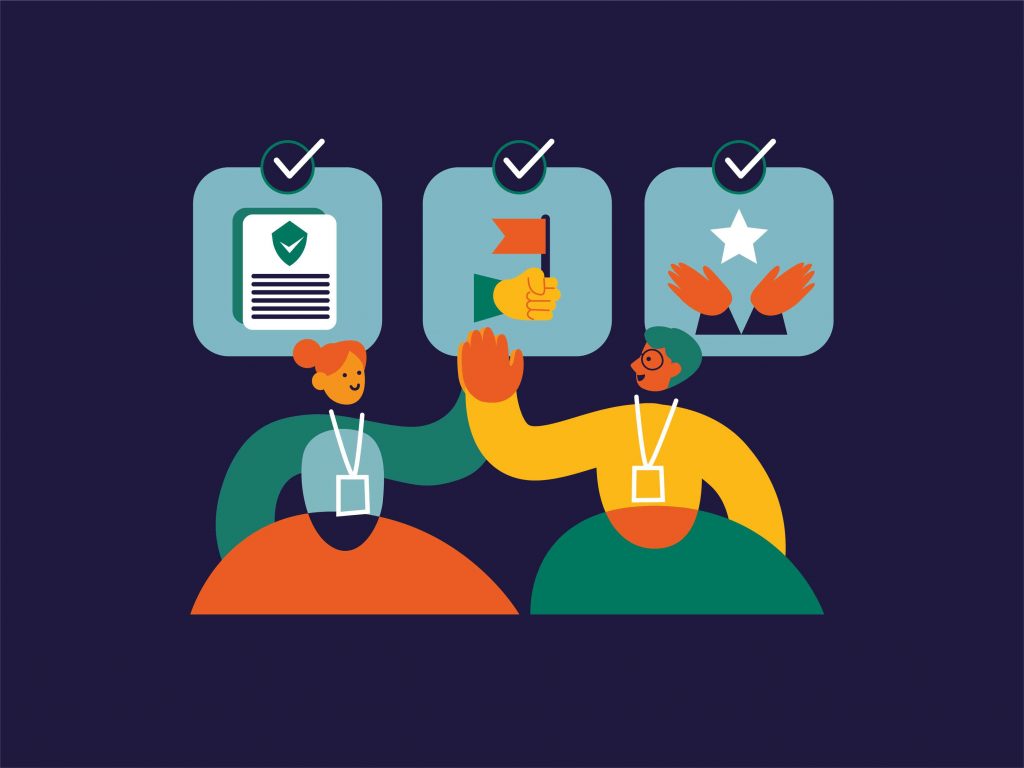Employee training is crucial to every business. However, the training courses often get a bad reputation for being boring or unnecessary. We have to ask the question: is the training boring or is it the way we conduct it that is boring? There are different types of training for employees. Each type matches a specific topic or issue. So, the question isn’t how many types of employee training are there. It’s which type best suits your needs. Check out the 10 different types of employee training programs below and decide which one’s for you.
10 Different Types Of Employee Training Programs
1. Soft Skills Training
Soft skills training entails training programs that focus on developing personality traits to promote a fluent and cooperative working environment as well as a business space. Foundational skills are the center of these programs. Employees can learn communication skills, project management, strategy, and leadership. In certain situations, Digital Training Managers can include other skills or technical knowledge required to use a specific software or tool.
These skills are useful for both veterans and rookie members of the company. They help build a respectful, collaborative, and efficient culture within your organization.
Soft skills training works best when you want to assist employees in developing productive traits. Those who are about to become a manager or recently promoted into a leadership position also need to hone their soft skills.
To get a better hold of this type of training, take a look at the example below:
Integrity’s Leadership Training Programs
Integrity and Values (I&V) is the global leader in behavior change, executive coaching, and team development. In this project, they seek to provide training courses that develop and strengthen leadership skills. Our creators at F.Learning Studio help them design fun but informational series using smooth animations and captivating voice-overs. It oozes the formal vibe of leadership yet is relatable and friendly.
2. Compliance Training
By definition, compliance training is any training program that all employees must take. It should cover all the information your employees need to ensure the company runs efficiently. There are various types of training for compliance, such as safety training, data protection training, and anti-harassment training. For example, a medical corporation and a tech startup require very different conditions as a result of their profession. Hence, their business-specific compliance training programs should also be different.
A compliance training course is required when you need to update information regarding company-wide technical issues or policies. To put it simply, when there’s something that all of your staff members must know, plan a compliance training program. You should address any problem threatening the company’s ability to function, both efficiently and legally.
Here’s an example of compliance training.
One QBE’s Staff Remote Training
One QBE Insurance Group is one of the world’s top 20 general insurance and reinsurance companies. They employ over 14,500 people in 37 countries. The company needs a consistent way to train all staff members. Enter animated training videos. See how compliance training is delivered so engagingly with animation by F.Learning Studio.
Recommend reading:
3. Orientation Training
Orientation training is the one that new employee gets when they first join the company. Every business has employee orientation training as it is necessary for a smooth transition. The training content is simple because it focuses on welcoming new employees and introducing them to the company. A company’s orientation program can be formal or informal. It usually takes the first week on the job to ensure new hires skip a rough start.
An orientation training program is how your company welcomes new employees. This type of training, unlike the other different types of training for corporate, is often handled by the HR department. The program introduces recruits to the corporate culture, mission, vision, and values.

Update training method for a more engaging expeirence in the New Normal, through actual successful case studies.
Enhance Training Experience in the New Normal with Animation
4. Onboarding Training
Orientation training is part of a larger process known as onboarding training. It’s a series of corporate-specific training sessions that take place over time. Onboarding training covers essential topics to starting out at your company. This type of training specifically focuses on new employees, which separates it from compliance training.
Onboarding training should cover the essentials and the essentials only. Try to avoid overwhelming new employees with too much information. Show them how to use tools or software, execute communication practices, access support resources,… In other words, include things that are necessary for an employee to get on board with their work.
You can use onboarding training to walk new employees through what they need to know during their early weeks. Should there be more information, add it gradually as time goes on. Leaving them self-study manuals or guidelines is also an option.

5. Technical Training
A technical training program explains the use of any technology or tools at your company. It shows employees how to use certain software or devices. This is the only type of training that has an extremely variable duration. It depends on the complexity of the tool or software. The more complicated things are, the more you need to explain.
You should only assign technical training programs to employees who must learn it. There’s no point in training a front desk receptionist about how to operate a conveyor system. Remember, technical training isn’t always mandatory. Avoid feeding employees with irrelevant information. It may overwhelm them.
The following example may shed some light on the matter.
Pro Cloud Architecture Internal training
interested to know more?
Glad you like us! Book a consultation call with us to explore how to kick start your animation project.
Pro Cloud Architecture sets out to improve employee proficiency to compete with their rivals. The training video above is part of their training program, developed by F.Learning Studio. The course explains how cloud data transfer works using animation and voice-over. F.Learning Studio chose a neutral design for this project, eliminating cultural differences or generation gaps. It helps the training appeal to a larger group while keeping it memorable.
6. Product And Service Training
Product and service training programs are one of the most common types of corporate training. It covers any products or services you offer. They briefly go through the features of each. This type of training is different from technical training. Not only do you teach employees how to use the product, but you also show them the unique selling point for each product or service your company offers.
The key information to cover in product and service training should be features, warranty, and commonly asked questions. Make sure your employees understand the product or service, both for internal and business purposes. However, the main point of this type of employee training isn’t to market and sell.
7. Sales Training
Sales training is a specific type of training that’s similar to product and service training. However, it emphasizes the selling points and skips the granular product details. The purpose of sales training is to help employees market and sell the product. It should demonstrate how one can effectively promote the product, navigate difficult customer questions, and showcase unique features.
Sales training is mandatory for salespeople. It allows them to sell using knowledge about the product. This type of training usually utilizes role-playing of real-life scenarios. That way, your employees can experience first-hand how they can sell the products or services.
8. HSE Training
Health, Safety, and Environment training (HSE training for short) deals with any knowledge and skills your employees need to perform their duties safely and effectively. This type of training informs possible hazards and risks associated with specific work activities. It also instructs staffers on how to identify, report, and address the incidents.
HSE training is vital and universally performed by many organizations. HSE training sessions can be held by in-house experts. Organizations also have the option to hire external practitioners to train their employees. Most HSE materials educate employees on keeping themselves safe from prominent workplace injuries or accidents. Ergonomics can be part of this training. It’s crucial to help those who have to sit for long hours to stay healthy and efficient.
Businesses use HSE training to raise employees’ awareness about workplace safety and health-related issues. It’s particularly vital in more danger-prone industries. In sectors with lower risks, organizations may focus on preparing employees for a fire or an earthquake.
Let’s visit an example.
IntelyCare Fire Safety Training
The purpose of IntelyCare was to provide basic knowledge about fire safety to their audience. Fire is the number one workplace hazard. For the video, IntelyCare didn’t put anyone’s life at risk but resorted to animation by F.Learning Studio. We went with a familiar design to get the message across easier. In the end, we’re more than happy to help workers learn how to prevent such a hazard from happening in the workplace.
To learn more about HSE training, check out these amazing examples of Animated Health And Safety Training Videos.
9. Leadership Training
Leadership training is a structured program designed to develop individuals’ skills and abilities to lead, manage, and inspire others effectively. It typically covers various topics such as communication, decision-making, team management, conflict resolution, emotional intelligence, and strategic planning.
The goal is to equip current and future leaders with the knowledge and tools they need to drive organizational success. This, as a result, fosters a positive work environment and adapts to changing business landscapes. Leadership training can be tailored to different levels of leadership, from emerging leaders to senior executives, and is often a critical component of professional development in many organizations.
10. Diversity Training
Diversity training is all about helping people understand, appreciate, and embrace the differences in others, whether it’s culture, race, gender, or other unique characteristics. It’s a way to build a more inclusive and welcoming environment where everyone feels valued and respected. These sessions include lessons about how to recognize and challenge biases, communicate more effectively across diverse groups, and create a workplace culture that celebrates everyone’s unique contributions.
What are the Benefits of Employee Training Programs?
What will your business get out of employee training?
- Skilled workers: Employees can constantly learn new skills and hone their native competence.
- Reduced turnover rate: When you allow employees to develop themselves to their full potential, there’s a high chance that they will stay with your organization.
- Increased profit and growth: A skilled and cooperative workforce always brings greater results.
- Good reputation: Build your brand’s image by paying attention to employee training.
- Deeper skill succession pipelines: A regular and well-developed training program will help uncover talents who can take charge of leading the business.
As for your employees, they will gain:
- Career advancement: Better skills mean better chances of getting promoted to a higher position.
- Self-development: Access to new knowledge to constantly develop efficiency and launch their professional careers.
- Enhanced productivity: New techniques and technology will unlock better proficiency for your employees.
How to Make Employee Training Programs Effective
1. Create Interactive Experience
Nothing is more engaging than interactive experiences. You can start by incorporating interactive elements — these allow employees to actively participate by making choices, answering questions, and exploring different scenarios. Next, use collaborative learning tools like discussion boards, group projects, or shared digital whiteboards. These tools encourage teamwork and let employees learn from each other’s insights and experiences.
2. Incorporate Technology into Your Training Session
Incorporating technology seamlessly into training sessions can make it less demanding and more interesting. One go-to choice for many trainers is the Learning Management System (LMS). An LMS is like your all-in-one hub for training—it organizes, tracks, and delivers training content to your employees in a way that’s easy and convenient for everyone. Employees can access courses anytime, anywhere, and you can keep tabs on their progress with just a few clicks.
3. Provide Customized Training Programs
The most effective programs is the one that’s suitable with your learners. Everyone prefers a different learning style, so it’s important for you to customize your training programs. Customized training means you can adapt the content to fit different learning styles—some might prefer hands-on activities, while others might learn best through videos or reading. In the end, everyone gets the most out of their training, leading to better performance and happier employees!
Conclusion
All the different types of training for employees are not to be neglected. However, knowing when and where to use which type of employee training is only the first step toward growth and positive morale. To achieve better knowledge retention, engagement, and results, upgrade your content delivery.
If you’re developing high-quality employee training programs that are engaging and effective with a touch of fun, F. Learning Studio is here to invite you to the future of employee training. Being an expert in the field, we can provide you with an all-in-one solution, from analyzing learners’ styles to creating interactive elements to boost your course.
Reach out to us to stay ahead of the curve!
- WhatsApp: (+84) 378 713 132
- Email: [email protected]
- Fanpage: https://www.facebook.com/f.learningstudio
- LinkedIn: https://www.linkedin.com/company/f-learning-studio/
You May Also Like:








